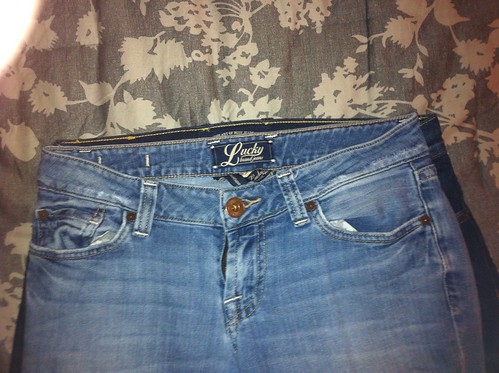I don't think it would be inaccurate to assume that most of my readers are female, and based on that assumption, to further deduce that we've all experienced the horror that is trying to buy clothes that fit. It may even be the reason that some of us learned to knit in the first place.
The sizing system used for women's clothes in the U.S. (and possibly elsewhere, but I'll talk about what I know) is based on meaningless numbers. Like 4. What is 4? 4 has absolutely no meaning. There are no standards. Each manufacturer can slap a "4" label on whatever size pants they feel like. And every year, 4 seems to get just a little bit bigger around the world.
In the last 2 years, I've gained about 10 pounds. This is not an absurd amount of weight, and it doesn't make me morbidly obese, but logic leads me to believe I should be buying a larger pants size, or, at the very least, that my usual pants size should be feeling a bit snugger.
It's not.
I don't know if manufacturers are trying to boost my self-esteem, or if they just think I'm really bad at math.
One of the articles of clothing we hear women complaining about more than any other is jeans. But I thought I had nipped this problem in the bud a few years ago when I discovered Lucky Brand jeans. They come in a variety of cuts and styles, 4 lengths, and most importantly, are sold by waist size. 2 = 26", 4=27", and so on. It's right there on the label. (They are a little pricey, but at least twice a year Lucky has sales that will chop about $40 off the price tag.)
Waist size is great. It is not meaningless. 27 inches is 27 inches. It is a measurement. There are standards. If something is labeled 27 inches, I can measure and verify that it is, in fact, 27 inches.
Or so I thought. For the last 3 years, I have been living firm in the belief that 27 inches has a universal significance. (Even if you use the obviously superior metric system, 27 inches still has a significance, it just may not mean anything to you personally. And really, it shouldn't, because the metric system is practically perfect in every way, and I don't know why we don't use. But that's a different post for another time.)
This belief came crashing down around me on Christmas Day.
Every year for Christmas, my sister and I buy each other a pair of Lucky Brand jeans. Because, of course, there's no need to try the jeans on--if you have a 27" waist, you buy 27" pants, done.
Ha ha.
Here we have, on top, my oldest pair of Lucky Brand jeans, purchased approximately 3 years ago, maybe 4. And beneath them, the pair of jeans I bought my sister for Christmas, which are enormous on her, and huge on me.
Both pairs of jeans are labeled 27". And what's more absurd is that the top pair are low rise, which means you might expect the waist to be larger since they're meant to fall closer to the hips, while the bottom pair are "easy rider," which are meant to fall at the waist.
Now, given the different cuts Lucky Brand sells, all of their jeans are clearly not going to fit the exact same way, that's expected. But I whipped out my handy tape measurer and discovered that the waist on the bottom pair of jeans is nearly 32"! Thirty. Two. Inches.
And, to add insult to injury, the jeans my sister bought me, also 27", fit perfectly. So not only has Lucky Brand fallen prey to the universal plot to make women feel better about themselves by slapping meaningless numbers on their jeans, 27" is now not even a standard measurement within the brand!
I feel lost, adrift in an ocean of ill-fitting clothing. I had bucked the system. I had found jeans that I knew would fit correctly. It was all mine. For a brief shining moment.


1 comment :
My mom worked in a sewing factory years ago and if they didn't have enough of a size for the shipment, they grabbed sizes they had extra of and sewed in the label for the size they needed more of.
Needless to say, after that we always tried on clothes.
Post a Comment